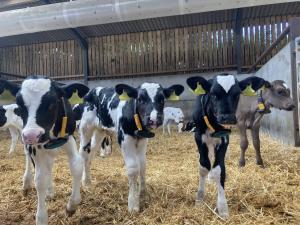
By Vet Paul Kirkwood
It is well known that colostrum is vital for newborn dairy and beef calves.
Calves are not born with any antibodies and rely solely on colostrum for these. The antibodies are essential for calves to stay healthy, grow efficiently and maximise their future productivity.
Colostrum is also very rich in energy and nutrients that are very important for a calf’s growth and development.

Diseases such as scour, pneumonia, joint ill and septicaemia are all influenced by colostrum intake. Excellent hygiene is also vital so the calving pen should be bedded daily, cleaned out regularly and colostrum feeding equipment should be washed after every feed.
An easy way to remember colostrum intake for calves is to remember the 4 Qs - Quantity, Quality, Quickly and sQueaky clean.
Four litres of high quality colostrum (~10% bodyweight) is needed within the first 6 hours of life with another feed of 3-4 litres within 12 hours of birth. Colostrum quality decreases over time so the sooner a calf receives colostrum the better.
It is highly recommended to test all colostrum quality prior to feeding it using a brix refractometer. A reading above 22% on a brix would classify as high quality and should be fed.
Ideally, colostrum less than 22% should not be fed to calves. Using a brix refractometer has the added benefit as excess colostrum with a value above 22% can be frozen (providing it is from cows which have tested negative for Johne’s disease). It can subsequently be thawed and fed if a cow or heifer gives birth and has little or no colostrum or it is of poorer quality.
Although the brix refractometer is good for measuring colostrum quality, it is also important to measure the success of this passive transfer following colostrum feeding.
This success or failure of passive transfer to calves can be carried out by taking a blood sample from the neck of calves that are 2-7 days old and measuring the total protein (TP). This gives a farm a good indication into the quality of the colostrum from the cow as well as whether or not the calf is receiving enough clean good quality colostrum quickly enough.
It is a very good monitoring tool throughout the year as it gives an insight into the management of dry and transition cows - poor colostrum quality and quantity can be a reflection of management and dietary issues within these groups.
Recently, there has been a new way of interpreting the results of TPs rather than simply the traditional pass (above 5.5 g/dL) or fail (below 5.5 g/dL). This scale gives the farm targets to aim for and will hopefully motivate staff to want to achieve the best results possible.
Total protein value (g/dL):
>6.2 = Excellent
5.8 – 6.1 = Good
5.1 – 5.7 = Fair
<5.1 = Poor
The target is for as many calves as possible to achieve excellent or good results which will help calves to stay healthy and will have the added benefit of lowering the infection pressure for calves which may have a lower TP value.
In a recent study, calves with poor TPI had (compared to those with excellent TPI) a 64% lower chance of reaching first insemination, a 55% lower chance of successful insemination and a 24% lower chance of reaching their first lactation.
Calves are the future of any herd so focussing on colostrum handling is an excellent investment for your farm. If you would like to know more about monitoring passive transfer in calves then speak to your vet.